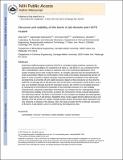Structure and stability of the lamin A tail domain and HGPS mutant
Author(s)
Qin, Zhao; Kalinowski, Agnieszka; Dahl, Kris Noel; Buehler, Markus J
DownloadBuehler_Structure and stability.pdf (1.824Mb)
PUBLISHER_CC
Publisher with Creative Commons License
Creative Commons Attribution
Terms of use
Metadata
Show full item recordAbstract
Hutchinson–Gilford progeria syndrome (HGPS) is a premature aging syndrome caused by the expression and accumulation of a mutant form of lamin A, Δ50 lamin A. As a component of the cell’s nucleoskeleton, lamin A plays an important role in the mechanical stabilization of the nuclear envelope and in other nuclear functions. It is largely unknown how the characteristic 50 amino acid deletion affects the conformation of the mostly intrinsically disordered tail domain of lamin A. Here we perform replica exchange molecular dynamics simulations of the tail domain and determine an ensemble of semi-stable structures. Based on these structures we show that the ZMPSTE 24 cleavage site on the precursor form of the lamin A tail domain orients itself in such a way as to facilitate cleavage during the maturation process. We confirm our simulated structures by comparing the thermodynamic properties of the ensemble structures to in vitro stability measurements. Using this combination of experimental and computational techniques, we compare the size, heterogeneity of size, thermodynamic stability of the Ig-fold, as well as the mechanisms of force-induced denaturation. Our data shows that the Δ50 lamin A tail domain is more compact and displays less heterogeneity than the mature lamin A tail domain. Altogether these results suggest that the altered structure and stability of the tail domain can explain changed protein–protein and protein–DNA interactions and may represent an etiology of the disease. Also, this study provides the first molecular structure(s) of the lamin A tail domain, which is confirmed by thermodynamic tests in experiment.
Date issued
2011-05Department
Massachusetts Institute of Technology. Department of Civil and Environmental Engineering; Massachusetts Institute of Technology. Laboratory for Atomistic and Molecular MechanicsJournal
Journal of Structural Biology
Publisher
Elsevier
Citation
Qin, Zhao, Agnieszka Kalinowski, Kris Noel Dahl, and Markus J. Buehler. “Structure and Stability of the Lamin A Tail Domain and HGPS Mutant.” Journal of Structural Biology 175, no. 3 (September 2011): 425–433.
Version: Author's final manuscript
ISSN
10478477
1095-8657